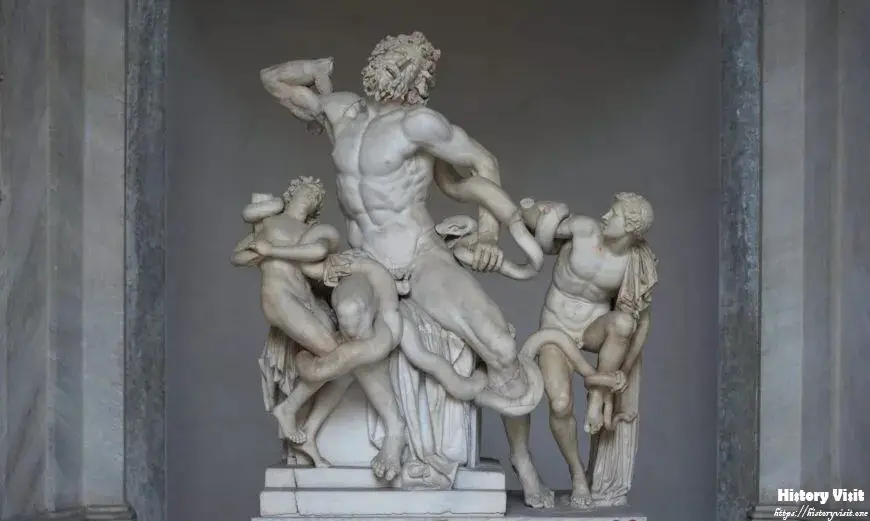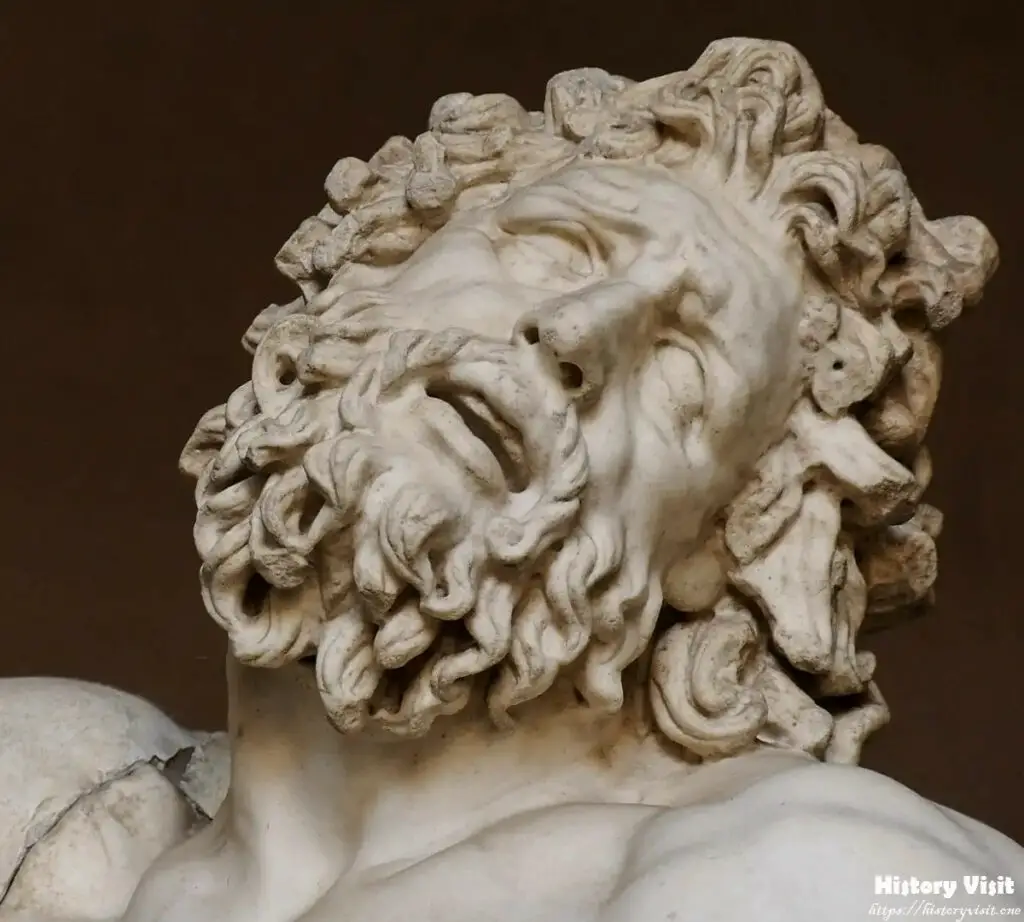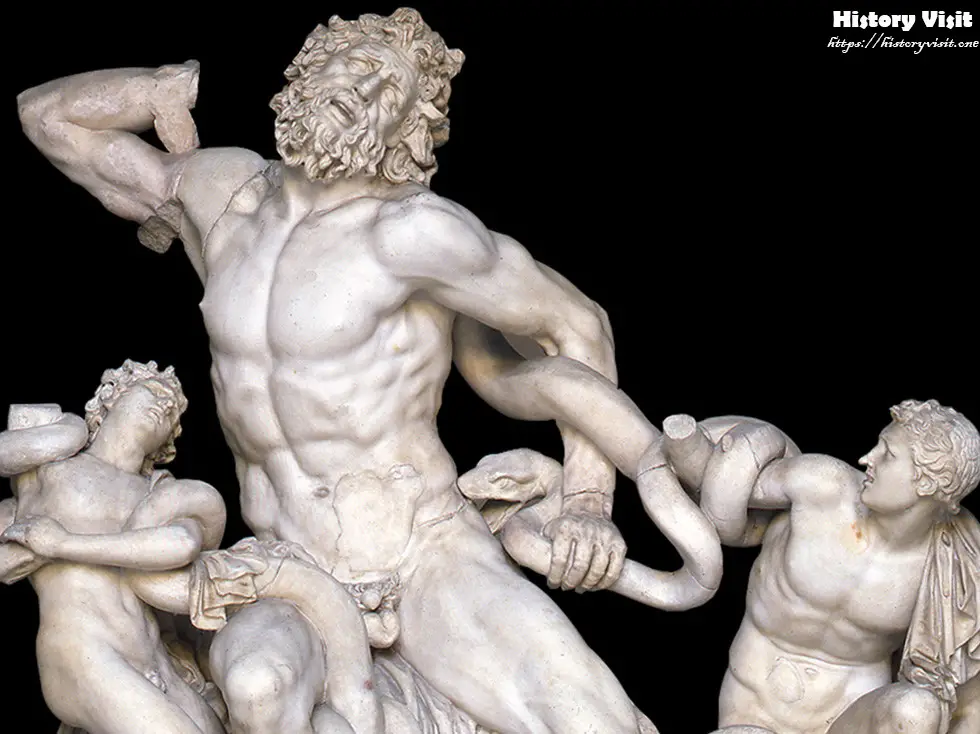Unraveling the Myth: Laocoön and His Sons

Introduction
Nestled within the illustrious halls of the Vatican Museums in Vatican City stands a timeless masterpiece that has captivated generations of art enthusiasts — “Laocoön and His Sons”. Crafted around 40-30 BC by the skilled hands of Agesander, Athenodoros, and Polydorus, this sculpture is a quintessential representation of the Hellenistic period’s artistic prowess. Its sheer magnitude and emotive power make it a focal point for those seeking to delve into the realms of classical mythology and artistic expression.
The placement of “Laocoön and His Sons” within the Vatican Museums holds profound significance. Positioned amidst an array of other classical masterpieces, it not only serves as a testament to the enduring legacy of ancient Greek art but also invites contemplation on the intersection of religion, politics, and human emotion. As visitors traverse the halls, they are transported back in time, invited to unravel the enigmatic tale depicted within the marble confines of this iconic sculpture.
Historical Context

To comprehend the essence of “Laocoön and His Sons,” one must first delve into the rich tapestry of Greek mythology and the tumultuous events of the Trojan War. Laocoön, a figure from Greek mythology, was a priest of Apollo in the city of Troy. His tragic tale unfolds in the writings of Virgil’s “Aeneid,” where he incurs the wrath of the gods by warning the Trojans of the danger posed by the infamous wooden horse. In retaliation, Poseidon sends sea serpents to strangle Laocoön and his sons, thus sealing the fate of Troy.
The sculpture itself embodies the essence of the Hellenistic period, characterized by its emphasis on naturalism, dramatic expression, and emotional intensity. “Laocoön and His Sons” exemplifies these traits through its dynamic composition and lifelike depiction of agony and despair. Created during a time of political upheaval and cultural transition, it reflects the tumultuous spirit of an era marked by shifting power dynamics and the collision of diverse cultures.
Description of the Sculpture

Standing over seven feet tall, “Laocoön and His Sons” commands attention with its monumental presence and intricate detail. Carved from a single block of marble, the sculpture depicts Laocoön and his two sons entangled in the coils of two massive serpents. The contorted bodies and anguished expressions of the figures evoke a visceral response from viewers, conveying a sense of desperation and impending doom.
The central figure of Laocoön serves as the focal point of the composition, his muscular frame straining against the serpents’ grip as he struggles in vain to free himself and his sons. The younger figures, his sons, writhe in agony beside him, their faces contorted in terror. Every sinew and muscle is rendered with exquisite precision, imbuing the sculpture with a sense of realism that borders on the surreal. The serpents, with their sinuous coils and menacing visages, coil around the trio like malevolent specters, their presence looming ominously over the scene.
The scene depicted in “Laocoön and His Sons” captures a pivotal moment in Greek mythology, frozen in time for eternity. It serves as a poignant reminder of the fragility of human existence and the capricious nature of divine intervention. As viewers gaze upon the sculpture, they are transported back to ancient Troy, bearing witness to the tragic fate of Laocoön and his sons.
Symbolism and Interpretation

At its core, “Laocoön and His Sons” is a meditation on the themes of fate, suffering, and the struggle against seemingly insurmountable odds. The sculpture serves as a metaphor for the human condition, depicting the eternal struggle between man and the forces that seek to destroy him. Laocoön, a symbol of defiance in the face of adversity, represents the indomitable spirit of the human soul, while the serpents embody the inexorable forces of fate and destiny.
The narrative depicted in “Laocoön and His Sons” also carries profound religious and political implications. In Greek mythology, the gods often intervened in the affairs of mortals, shaping the course of history according to their whims and desires. Laocoön’s fate serves as a cautionary tale against defying the will of the gods, highlighting the consequences of hubris and disobedience. Furthermore, the sculpture’s portrayal of suffering and sacrifice resonates with themes of martyrdom and redemption, offering a glimpse into the moral complexities of the ancient world.
In addition to its allegorical significance, “Laocoön and His Sons” has been interpreted through various artistic and philosophical lenses over the centuries. From the Renaissance to the present day, artists and scholars have drawn inspiration from its timeless beauty and emotional depth, reimagining its themes in new and innovative ways. Whether viewed as a masterpiece of classical art or a profound meditation on the human condition, the sculpture continues to provoke thought and inspire awe in all who encounter it.
Artistic Influence and Legacy

The influence of “Laocoön and His Sons” extends far beyond the confines of its marble pedestal, permeating the annals of art history and shaping the course of Western civilization. From the Renaissance to the modern era, artists have drawn inspiration from its dynamic composition and emotive power, seeking to capture the essence of its timeless beauty in their own works. Michelangelo, in particular, was deeply influenced by the sculpture’s dramatic intensity, incorporating elements of its style into his own masterpieces.
Beyond its artistic influence, “Laocoön and His Sons” continues to serve as a touchstone for scholars and historians seeking to unravel the mysteries of ancient Greece. Its depiction of classical mythology and the human experience offers valuable insights into the cultural and philosophical currents of the Hellenistic period, shedding light on the complex interplay of religion, politics, and society. As such, it remains a cherished symbol of Western civilization’s enduring fascination with the classical past.
In conclusion, “Laocoön and His Sons” stands as a testament to the enduring power of art to transcend the boundaries of time and space. Through its timeless beauty and profound emotional resonance, it invites viewers to contemplate the mysteries of the human condition and the eternal struggle between fate and free will. As visitors stand before its majestic form in the hallowed halls of the Vatican Museums, they are reminded of the enduring legacy of ancient Greece and the enduring power of the artistic imagination.
Conclusion

In conclusion, “Laocoön and His Sons” transcends its status as a mere sculpture to become a profound meditation on the timeless themes of fate, suffering, and the indomitable spirit of the human soul. Crafted with meticulous detail and imbued with emotional depth, it stands as a testament to the enduring power of art to provoke thought, inspire awe, and transcend the boundaries of time and space.
As visitors stand before this iconic masterpiece in the Vatican Museums, they are transported back in time to ancient Troy, bearing witness to the tragic fate of Laocoön and his sons. Through its dynamic composition and lifelike portrayal of agony and despair, the sculpture invites viewers to contemplate the fragility of human existence and the capricious nature of divine intervention.
Moreover, “Laocoön and His Sons” continues to exert a profound influence on the course of Western civilization, shaping the artistic, philosophical, and cultural currents of subsequent centuries. Its legacy lives on in the works of artists and scholars who seek to capture the essence of its timeless beauty and unravel the mysteries of the classical past.
In the end, “Laocoön and His Sons” serves as a poignant reminder of the enduring relevance of classical mythology and the enduring power of the artistic imagination. As long as it stands within the hallowed halls of the Vatican Museums, it will continue to inspire awe and wonder in all who encounter it, inviting viewers to contemplate the mysteries of the human condition and the eternal struggle between fate and free will.



